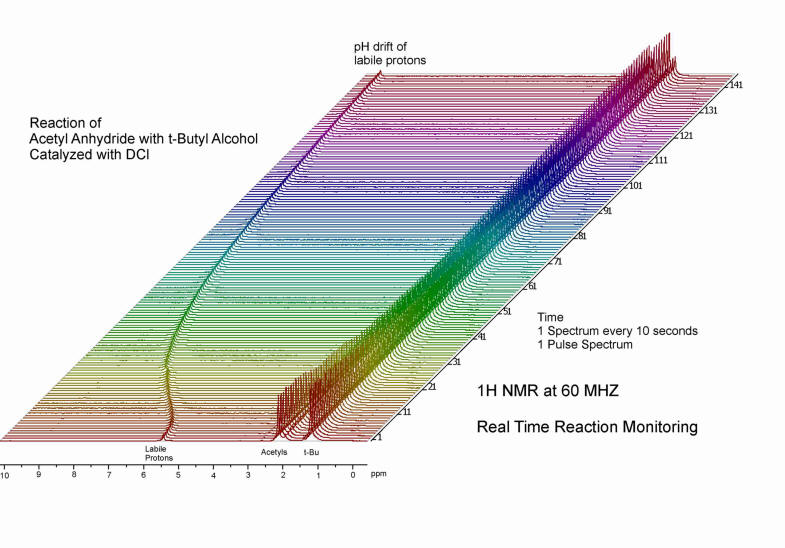

- Mestrenova stacked spectra colors software#
- Mestrenova stacked spectra colors series#

The higher harmonics increase more than do The power of every harmonic increases with time, so the soundīecomes louder. The frequencies of the spectral lines are constant. In this example, the pitch doesn't change, so In the spectrogram, the harmonics appearĪs horizontal lines. Observe the harmonics, which appear as equally spaced components In false colour (blue is weak, red is strong). On the vertical axis, and sound level (on a decibel scale) Spectrogram (lower figure) shows time on the x axis, frequency Over the first and last 0.3 seconds of the sound file. In this figure, the two upper figures are spectra, taken Pitch and loudness, you will notice that there is a big differenceĬrescendo played on a trombone. That determines the timbre is the relative size of the different Have the same pitch and the same loudness.) One of the things Qualities that are different in two different sounds which (Timbre has a negative definition - it is the sum of all the Pitch then you are, by definition, changing its timbre. If you change a sound without changing its loudness or its If youĬhange the pitch, the frequency of all of the components increases. If you change the loudness, the size (orĪmplitude) of the spectral components gets bigger. Notes on a musical instrument) into the microphone and lookingĪt their spectra. If how have these, you can learnĪ lot about spectra by singing sustained notes (or playing
Mestrenova stacked spectra colors software#
Many software packages for sound analysis or sound editing have the software that can take a short sample of a sound recording, perform the calculation to obtain a spectrum (a digital fourier transform or DFT) and display Your computer probably has the hardware to do this already a computer which performs a calculation upon these numbers.
Mestrenova stacked spectra colors series#
Series of numbers (representing the microphone voltage)
an analogue-digital converter which converts this to a. a microphone which measures the sound pressure over a. Today, sound spectra (the plural of spectrum is spectra) are usually Spectrum as a sound recipe: take this amount of that frequency,Īdd this amount of that frequency etc until you have put together Hertz, abbreviation Hz) or thousands of vibrations per second The power or pressure is usually measured in decibelsĪnd the frequency is measured in vibrations per second (or It is usually presentedĪs a graph of either power or pressure as a function of frequency. Of vibration at each individual frequency. – usually a short sample of a sound – in terms of the amount Of high notes and low notes, and some sounds (such as drum beatsĪnd cymbal crashes) which have no clear pitch.Ī sound spectrum is a representation of a sound Music playing in the background, in which case there is a mixture Wind outside, the rumble of traffic - or perhaps you have some Sound of the fan in your computer, perhaps the sound of the If you are reading this on the web, you can probably hear the (There is an introduction to sound and vibrations in the document "How woodwind instruments work".) Most sounds are made up of a complicated mixture of vibrations. You can move the two control points around until they only show the gradient from red to blue :)Īlternatively, you could use the Gradient Editor to flip the order of the colors and delete all the colors before and after red and blue.A sound spectrum displays the different frequencies present in a sound. Unfortunately, you can only do this by making a big gradient with all of the colors, the SVG standard has no flag for "visible light gradients". Colors outside theĬolor gamut of the device, such as most spectral colors, can only beīut let's say you want to make the approximation in InkScape. Reproduce all colors discernible by a human eye. computer monitors and televisions) cannot Now technically, your question has no answer, because.Ĭolor displays (e.g. RGB is a method to trick the eyes to see many colors with few colors, just like CMYK. The spectrum of visible light doesn't work this way though, because real world color isn't RGB. G = firstColor.G * p + secondColor.G * (1 - p)ī = firstColor.B * p + secondColor.B * (1 - p) R = firstColor.R * p + secondColor.R * (1 - p) This has to do with the algorithm that InkScape and other graphics programs use to create gradients, namely (pseudo-code): var gradient =






 0 kommentar(er)
0 kommentar(er)
